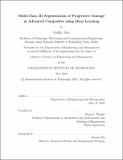Multi-Class 3D Segmentation of Progressive Damage in Advanced Composites using Deep Learning
Author(s)
Jain, Sudhir
DownloadThesis PDF (26.21Mb)
Advisor
Wardle, Brian L.
Terms of use
Metadata
Show full item recordAbstract
Carbon fiber reinforced polymer (CFRP) composites are playing an increasingly important role in modern aerospace primary structures. Underpinning their growing utilization is their relatively high mass-specific stiffness and strength, together with tailorable bulk mechanical properties. However, while being key drivers of such performance benefits, CFRP microstructural heterogeneity and mechanical property anisotropy are also associated with complex damage mechanisms that make failure prediction highly challenging, limiting CFRP performance knowledge and more efficient utilization. Typical damage mechanisms contributing to progressive failure fall into three categories, each of them manifesting as a crack of some sort: (i) delamination (interlaminar cracking), (ii) matrix cracking, and (iii) fiber breakage (crack through fiber). At present, X-ray computed tomography (CT) performed to observe these complex damage mechanisms in 3D and 4D (3D spatial and 1D temporal) is normally analyzed by manual or semi-automated segmentation techniques, where a user identifies and segments the different damage modes (e.g., internal cracks) in the 2D tomograms that comprise the 3D tomographic scan. However, these scans contain a large amount of data (≈10 GB/mm3 ) making it traditionally challenging to extract mechanistic insights in a reasonable time frame. Thus, as a promising approach to introduce efficiency, repeatability, and objectivity to the CT segmentation process for microscale damage in advanced composites, deep learning (DL)-based algorithms are developed here for automated (i) 2D binary segmentation of fiber break damage mechanisms, (ii) Multi-damage (fiber break and matrix crack) segmentation, and (iii) 3D multi-class segmentation of a benchmark sandstone dataset. Multi-class segmentation of microscale damage is proposed to automate CT segmentation in the advanced composite, leveraging 120,000 trained human-segmented tomograms containing labeled fiber breaks and 65,000 trained human-segmented tomograms containing labeled matrix cracks for training, validating, and testing DL models. Different methodologies for the selection of high-performance DL models are investigated. A training and validation study is used to select a high-performance 2D fiber break DL model, and performance of this DL model is found to be close to the human level for the segmentation of fiber breaks (≈93%) and enables consistent, reproducible, and scalable segmentation deployment without the need for human experts. Additionally, preliminary studies indicate a feasible pathway for 3D feature recognition (with ≈39% improvement in performance over 2D segmentation of sandstone dataset) and 2D multi-class segmentation containing composite fiber break and matrix crack data, termed as multi-damage multi-class segmentation. Future work involves combining multi-damage and 3D segmentation for full complex damage segmentation in advanced composites.
Date issued
2022-05Department
System Design and Management Program.Publisher
Massachusetts Institute of Technology